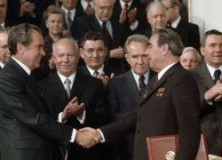SALT I: A Lesson in Security Policy — Matthew P. Jennings

INTRODUCTION:
The Cold War was characterized by distrust, arms races, and competing ideologies. Therefore, the world was surprised in March 1967 when Soviet Premier Alexei Kosygin and President Lyndon B. Johnson announced their joint intention to halt the U.S.-Soviet arms race and impose limits on various offensive and defensive weapons in their respective arsenals. External events intervened, however, and the first round of Strategic Arms Limitation Talks (SALT I) was delayed. The SALT I negotiations eventually began in November 1969 under President Richard Nixon. Following two and a half years of negotiations, the talks ended in May 1972 at a summit in Moscow, which produced the Anti-Ballistic Missile (ABM) Treaty and an Interim Agreement committing both sides to future negotiations regarding limitations on offensive weapons. There is a general consensus among secondary sources that interagency cooperation on foreign policy (including SALT I) during the presidency of Nixon was poor or virtually non-existent. Instead, Nixon and his National Security Advisor, Henry Kissinger, preferred to bypass the bureaucracy and control the national security process themselves. The result, according to some, was a sub-optimal outcome to the SALT I negotiations.
STRATEGY:
The U.S. government acted largely in an ad hoc manner with regard to the SALT I negotiations. Prior to the initial talks with the Soviets in Helsinki, there were no planning meetings between U.S. agencies to develop a clear, cohesive strategy for negotiating with Moscow, although there was a degree of preparation within the White House. Nixon and Kissinger formulated policy and developed contingencies among themselves, voluntarily bypassing other agencies. This process resulted in the absence of a clear, definite negotiating position and subsequently, the U.S. delegation departed for the initial SALT I meeting at Helsinki without specific direction from the White House. This practice was repeated throughout the negotiations, while real progress occurred in the back channels.
INTEGRATED ELEMENTS OF NATIONAL POWER:
In 1969, the Nixon administration in 1969 was characterized by a tendency toward blatant exclusion of various U.S. government entities. In contrast to President Johnson, who often gathered his top advisors for Tuesday lunch meetings, Nixon preferred a more centralized approach, making foreign policy decisions based almost entirely on his own views and with Kissinger’s recommendations. This close professional association and decision-making naturally disregarded other government agencies and a general atmosphere of interagency discord became the norm.
EVALUATION:
Interagency discord and distrust were strongly linked to ineffective cooperation between the White House and the executive agencies throughout the SALT I process. This was also evidenced by the lack of communication between key agencies, whose input is normally solicited in the policy-making process and may have been valuable to the negotiations at hand. Moreover, Nixon allowed his personal animosity for some agencies, such as the Department of State and the Central Intelligence Agency, to limit the development of an effective strategy. The back channel approach to diplomacy, established to circumvent the State Department and other agencies, exacerbated the ad hoc nature of Nixon’s approach to SALT I. On occasion, information from the back channel developments would be leaked to the formal U.S. delegation, which fostered the negotiating team’s suspicion of the White House. Yet, in some ways, the back channel approach proved useful during the SALT I process in that it allowed Nixon and Kissinger to communicate quickly and bypass the sometimes cumbersome, policy-making bureaucracy.
RESULTS:
The SALT I negotiations ended with mixed success. The two sides eventually were able to agree to terms of two important arms control documents, the ABM Treaty and an Interim Agreement regarding offensive weapons. However, many in the government considered the Interim Agreement a suboptimal achievement, since the document failed to include concrete freezes on Multiple Independently-targetable Reentry Vehicles (MIRV). The negotiations also exposed the dysfunctional communication of the U.S. national security apparatus. This brought not only international embarrassment upon the U.S. delegation, but cast a shadow on the United States’ image as an example of democratic decision-making.
CONCLUSION:
During the SALT I negotiations, interagency disagreement on the U.S. side was a recurring theme. There was a regular disconnect between developments in the formal negotiations and the back channel discussions. This case illustrates that if important foreign policy making processes are confined to one person, or even two close friends, as was the case with Nixon and Kissinger, then valuable viewpoints and perspectives are often left out and the foreign policy apparatus is not allowed to function to its full potential. Nixon and Kissinger’s barring of the bureaucracy in SALT I harmed U.S. government interagency relations and their attempts to reach breakthroughs in weapons limitations that may have included controlling the deployment of the MIRV Intercontinental Ballistic Missiles.